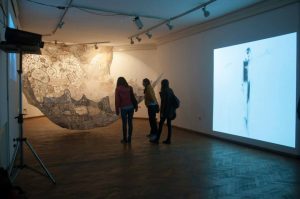
ANOUK LEDERL
/Culture manager (Romania/France)/
My first impression of the Danube Dialogue 2015 was like a rhapsody! It was perfectly orchestrated by Vesna Latinović and Sava Stepanov. On Monday September 7th we started by an immersion in Slovakia and then have a path to the discovery of others spaces conventionnels and non conventionnels in Novi Sad to finish with an insight of Serbia passing by Austria, Bulgaria, Slovenia and Montenegro. The curator and the artist of each country introduced us in their universe. We were like a procession in the City crossing the borders. The second day was also punctuated like a musical score. A very interesting symposium in the morning gave us the chance to encompass the subject Art in the age of (non) emotionality. The afternoon was dedicated to another travel in the city, passing by Hungary, Croatia, Germany, Romania, Bosnia and Herzegovina. The atmosphere was friendly and openminded with a lot of discussions between participants. Personally, I was really impressed by the work of Karl-Hein Ströhle (Austria) and Dan Maciuca and Vlad Ovariu (Romania). It was really an interesting insight about the new trends of Danube countries regarding visual arts.
ANA VRTAČNIK
/Painter (Serbia)/
Symposium Art in the Age of Emotion and Non-Emotionality is certainly a great experience. As a young artist, I have had the opportunity to hear a number of solid theory lectures from the field of visual thinking which I believe will be of great importance for my further research. Through rich personal experience, some of the biggest theorists and art historians have answered the question concerning the position of art at the time of (non)emotionality and how it responds to the requests of time in which it has been made. That is the finest charm of the symposium, conglomerate of different ideas and variations of responses to this, today, very timely topic.
SANJA KOJIĆ MLADENOV
/Director at the Museum of Contemporary art Vojvodina (Serbia)/
The circumstances that enable us to acquire broader insight into international art scene are of vital importance at the time of the disappearance or restructuring of many traditional fine art events in the region. Gradually developing and assembling more associates every year, Danube Dialogues Festival has become a rare place in the region where numerous contemporary art concepts can be presented by affirming the crucial idea of establishing dialogues and relations between the protagonists of the local and international, and especially regional art scenes. This year’s edition of the Festival, and its successful presentation, showed the importance of persistence and continual development aimed at constantly improving not only the quality of the flow of information based on experience and new partnerships, but also the conceptual approach to contemporary art in the Danube region.
LANA GUNJIĆ
/Manager in tourism and culture (Serbia)/
I was attending the festival Danube dialogues for the first time and I can only express satisfaction and a wish to be a part of it again next year. The festival has a lot to offer with its original concept, current topics and extremely interesting content. I applauded the dynamics, atmosphere and artistic environment, which keeps the public involved.
ERVIN EROS
/Director of Central European Service for Cross-Border Initiatives Balkans (Serbia)/
This year we had the honor to link the organization of the 7th Youth Forum “Youth as a Driving Force Behind the EU” with the opening of the Festival of Contemporary Art Danube Dialogues 2015. As one of the most important art events in the region, Danube Dialogues had an impact on the work of our Forum too, as young people, encouraged by the work of artists from the Danube region, subsequently engaged in constructive dialogue about their future. Bearing in mind the impressions of our participants and my own, I can say that the programme of this year’s Danube Dialogues was particularly interesting, provocative and inspirational. The attendance at the Festival showed that we need more art events with programmes and organization of this quality, and we hope that this Festival will become an event which will take place several times a year, to the delight of the entire region.
